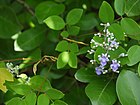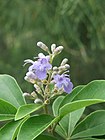Note: This is a project under development. The articles on this wiki are just being initiated and broadly incomplete. You can Help creating new pages.
Vitex trifolia - Jalanirgundi
Vitex trifolia is a large coastal shrub or small tree. and it is naturally found along coastlines from tropical East Africa as far east as French Polynesia.
Uses
Fever, Liver diseases, Constipation, Headache, Beriberi, Sprains, Contusions, Rheumatism, Swollen testicles
Parts Used
Chemical Composition
An essential oil and alkaloids have been isolated from the leaves and bark of this plant. Particularly leaves contain flavones, artemetin and 7-desmethyl artemetin and some non-flavonoid components[1]
Common names
| Language | Common name |
|---|---|
| Kannada | Karinochi, Lakki |
| Hindi | Nichinda |
| Malayalam | Chara-nosi |
| Tamil | Karunochi |
| Telugu | Chiruvavil |
| Marathi | NA |
| Gujarathi | NA |
| Punjabi | NA |
| Kashmiri | NA |
| Sanskrit | Indranika |
| English | Three-Leaved Chaste Tree |
Properties
Reference: Dravya - Substance, Rasa - Taste, Guna - Qualities, Veerya - Potency, Vipaka - Post-digesion effect, Karma - Pharmacological activity, Prabhava - Therepeutics.
Dravya
Rasa
Tikta (Bitter), Kashaya (Astringent)
Guna
Laghu (Light), Ruksha (Dry), Tikshna (Sharp)
Veerya
Ushna (Hot)
Vipaka
Katu (Pungent)
Karma
Kapha, Vata
Prabhava
Habit
Identification
Leaf
| Kind | Shape | Feature |
|---|---|---|
| Simple | Opposite | The leaves are divided into 3-6 toothed leaflets, with smaller leaflets in between |
Flower
| Type | Size | Color and composition | Stamen | More information |
|---|---|---|---|---|
| Unisexual | 3–23 cm | Yellow | 5-20 | Flowers Season is June - August |
Fruit
| Type | Size | Mass | Appearance | Seeds | More information |
|---|---|---|---|---|---|
| 5 mm long | Fruits yellow or reddish turning blue or black | Pubescent outside | - | {{{6}}} |
Other features
List of Ayurvedic medicine in which the herb is used
Where to get the saplings
Mode of Propagation
How to plant/cultivate
Requires a sunny position and a well-drained, preferably sandy soil. Plants are highly tolerant of salt in the air and in the soil. Established plants are very drought tolerant[3]
Commonly seen growing in areas
Photo Gallery
References
External Links
- Ayurvedic Herbs known to be helpful to treat Fever
- Ayurvedic Herbs known to be helpful to treat Liver diseases
- Ayurvedic Herbs known to be helpful to treat Constipation
- Ayurvedic Herbs known to be helpful to treat Headache
- Ayurvedic Herbs known to be helpful to treat Beriberi
- Ayurvedic Herbs known to be helpful to treat Sprains
- Ayurvedic Herbs known to be helpful to treat Contusions
- Ayurvedic Herbs known to be helpful to treat Rheumatism
- Ayurvedic Herbs known to be helpful to treat Swollen testicles
- Herbs with Dried folaige used in medicine
- Herbs with Whole herb used in medicine
- Herbs with common name in Kannada
- Herbs with common name in Hindi
- Herbs with common name in Malayalam
- Herbs with common name in Tamil
- Herbs with common name in Telugu
- Herbs with common name in Sanskrit
- Herbs with common name in English
- Habit - Deciduous Shrub
- Index of Plants which can be propagated by Seeds
- Herbs that are commonly seen in the region of Coastal sand dunes
- Herbs that are commonly seen in the region of Sandy meadows
- Herbs that are commonly seen in the region of Found in teak forest
- Herbs
- Lamiaceae




